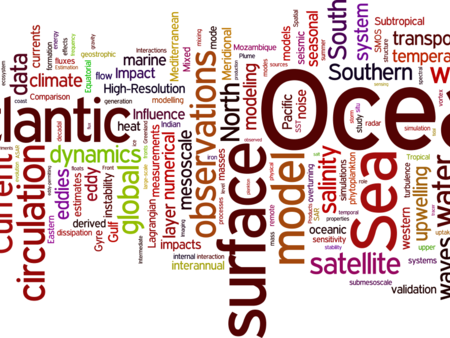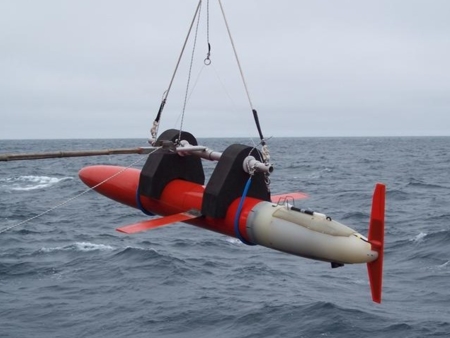Sea surface KInematics Multiscale monitoring: a proposal for ESA's Earth Explorer 9
The Sea surface KInematics Multiscale monitoring (SKIM) mission was a candidate mission for the European Space Agency's "Earth Explorer 9". SKIM is designed to measure surface currents, ice drift and waves, using a Doppler Ka-band radar... a new technique in space, but the basis of police 'speed-guns' used to check on car speeds. The proposing team is a multidisciplinary group with a main focus on ocean circulation in the tropics and around the edge of the sea ice, and many other applications. The detailed study (phase A) conducted by ESA between 2017 and 2019 has concluded on the technical feasibility of SKIM, and it was advised that ESA finds "other ways and means" to implement the mission. At present (November 2020), an ESA study is looking at the integration of SKIM on Sentinel 3 Next Generation. In this context, LOPS is working on improving the processing proposed for SKIM. More information here.
You can find more stuff (KMZs with orbits and the like) here: ftp://ftp.ifremer.fr/ifremer/ww3/TEAM/EE9/
and follow the latest developments on the SKIM website.
Here his the executive summary of the 2017 proposal:
New data needed for urgent challenges - Because the ocean surface is the interface between ocean, atmosphere and land, the ocean currents play an important role in defining the fluxes of heat, momentum, carbon, water, etc. between Earth System components. The ocean surface velocity combines surface currents (mainly driven by winds, density gradients, and tides), with wave-induced drift, known as Stokes drift. This total velocity transports surface heat, salt and everything that is in the upper ocean, natural or man-made, including microplastics. While largely improving over the passed satellite era, there is still a false sense of knowledge on ocean currents and waves. Satellite altimeters have been around for over 20 years, but along-track sea level anomaly and significant wave height are not enough to characterize the multi-scale motions of the oceans.
This is particularly true in the tropics where geostrophy explains a small fraction of surface currents and does not give access to the very important divergence and upwelling, the structure of which is poorly known. This is also true at the ice edge. The Arctic is going through a major regime change, with a widening Marginal Ice Zone (MIZ). A strong coupling is expected at the ice edge between ocean currents, ice, waves and atmosphere that is very difficult to observe today. It is urgent to add kinematic variables (surface current, ice drift, waves) that can be resolved at the relevant scales, smaller than those at which dynamic variables (sea level, wind stress) are available today.
Marginal Arctic seas are opening to more storms. Like everywhere else in the world, the spectral distribution of wave energy is required to investigate extreme sea levels. This spectral distribution is only available for long swells today with wave mode SARs, and it is a particular challenge to observe shorter waves that dominate in semi-enclosed seas, from the Mediterranean to the Baltic or Beaufort seas. Such a detailed sea state measurement would have far-ranging applications from ocean remote sensing with other missions to solid Earth monitoring with better known microseism sources.
What is SKIM and what it will measure - SKIM will open the era of satellite Doppler oceanography, combining nadir and near-nadir radar measurements. It will measure total ocean surface velocity vector (primary goal), using a Doppler technique that is more direct than altimetry for accessing surface currents, and ocean wave spectra (secondary goal). Planned as a five-year explorer experiment, this mission will address central questions for the understanding of our evolving climate, from the tropical current systems, to the rapidly evolving Arctic marginal ice zone. SKIM will demonstrate the maturity of Doppler oceanography, and pave the way for future Doppler missions. The proposed mission uses a high-resolution Ka-band Doppler altimeter, measuring at nadir and rotating off-nadir beams (0, 6 and 12° incidence angles). The expected accuracy on horizontal current velocity is 0.1 m/s, at a resolution of about 40 km. Flying on the 12 day-cycle Sentinel 1 (S1) orbit with a shift in longitude, SKIM will have a swath of 270 km that will allow overlap with S1 data and an ideal synergy for currents and wave sampling. SKIM will cover the world ocean up to 82° N, with daily coverage at latitudes beyond 70°, and an average of three passes per cycle at the Equator. This includes the Southern Ocean and both Arctic and Antarctic marginal seas. SKIM will image ocean current features, including eddies of diameter 80 km and more, a considerable extension of planned satellite altimeter missions capabilities. SKIM will also provide directional wave spectrum down to wavelengths of 20 m, and full azimuth coverage without direction ambiguity: these two aspects are clear improvement on existing and planned missions, giving a global coverage of oceans and regional seas.
From 2016 to 2017: a matured community and proposal - A multidisciplinary research community on ocean surface currents has emerged in recent years, thanks in part to the Globcurrent project, the development of analysis and processing techniques for swath altimetry in the framework of the SWOT mission, a better understanding of near-nadir Ka-band properties, the preparation for new types of spectral wave data from CFOSAT, and growing concern over microplastics and other contaminants. This particular context gave birth to the concept of the “Sea surface KInematics Multiscale monitoring” mission. Starting a few months before the 2016 EE9 call deadline, work towards the present proposal took a new dimension when the first end-to-end performance analysis showed that SKIM could be an effective follow-on of both SWOT for small-scale ocean currents and CFOSAT for waves, as well as a pathfinder for Doppler oceanography from space. Doppler oceanography has the unique capability to reveal the complex structures of equatorial upwellings and dynamics of marginal ice zones. The general design of SKIM was laid out in the 2016 proposal. The present proposal adds an end-to-end performance and error analysis, leading to adjustments in the measurement cycle, number of beams, etc., and a completely renewed proposing team, contributing to a mature proposal.
Innovation in SKIM lies in the combination of an improved altimeter design (high pulse repetition frequency, SAR mode, Ka-band), its integration with a proven rotating beam system inherited from the CFOSAT mission, and the use of Doppler measurements for both currents (Doppler centroid) and waves (Doppler modulation in range). The mission design also includes the capability for promising but less mature processing based on a Delta-K technique. SKIM could also carry an AIS receiver.
Mission objectives: SKIM objectives combine direct and short-term goals with a mature community and scientific basis, with a scientific readiness level or “SRL” of at least 4, including most steps needed for the demonstration of end to end performance (SRL 5),
- monitoring tropical currents and the structure of equatorial upwellings,
- observing dynamics and kinematics at the rapidly evolving marginal ice zones,
- providing sea state parameters relevant for coastal hazards and extreme waves,
- allowing a better understanding of other remote sensing data (e.g. L-band radiometry from SMOS, nadir altimetry, scatterometer winds…) thanks to spectrally resolved sea states and joint wave and current measurements.
Longer term goals appear more exploratory today (SRL 3) but will be achievable by 2025,
- observing wind stress vector fields over oceanic mesoscales
- characterizing strong submesoscale surface velocities
- mapping sources of microseisms for solid Earth monitoring
SKIM and the Earth Observation challenges - SKIM is primarily an “ocean mission” but it addresses challenges highlighted in ESA’s living planet programme (ESA-SP-1329/2), beyond the ocean. SKIM directly addresses C1 “Regional and seasonal distribution of sea-ice mass and the coupling between sea ice, climate (...)”, O2 "Mesoscale and submesoscale circulation", O4 "Physical and biogeochemical air-sea interaction processes", O5 “Sea level changes from global to coastal scales (...)”. SKIM will also contribute to the "Global Trends" strategy (improved modelling of air-sea coupling, oceanic vertical mixing and carbon uptake), and is related to the "increased exposure to disasters" (new observing capability for environmental monitoring and management). SKIM contributes to stimulating European economic growth and technological innovation, bringing unique new technological capabilities to augment existing international high resolution observing systems (e.g. Sentinel-1 & Sentinel-3, SWOT), supporting the evolution of European and international missions. More importantly, SKIM looks at the ocean in the context of the whole Earth system from the center of the core – hence the support of solid Earth scientists.
Time to fly: why EE9 is the right time for SKIM - After exploratory Doppler analysis of Envisat and Sentinel 1, SKIM will further pioneer the use of directional Doppler analysis to be the first mission capable of a global monitoring of surface vector currents, consistently derived with directional wave data. Coming at a time of transition in the Arctic, SKIM will be the first mission to measure currents and ice drift in the Marginal Ice Zone. SKIM will also constrain the coming atmosphere-wave-ocean coupled systems. This first space-borne mission for ocean kinematics will also demonstrate and assess different possible methods for surface current retrieval. This data will also help understand the Ka-band interferometric data from SWOT and provide a useful nadir altimetry beam, complementing the altimetry constellation. With unprecedented detailed measurement of directional sea state properties, useful for monitoring and correcting sea state biases, SKIM can become the prototype of future satellite altimeters, jointly measuring sea level, waves and currents.







